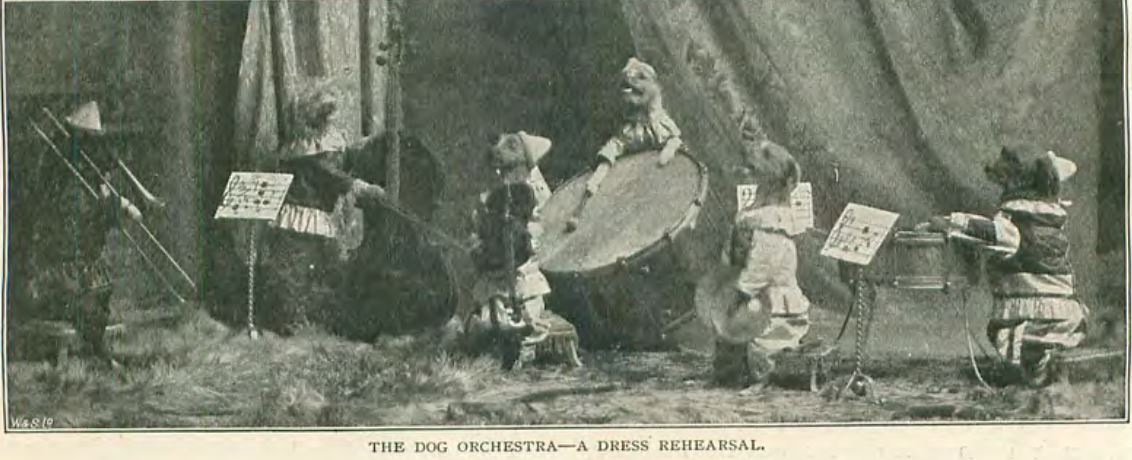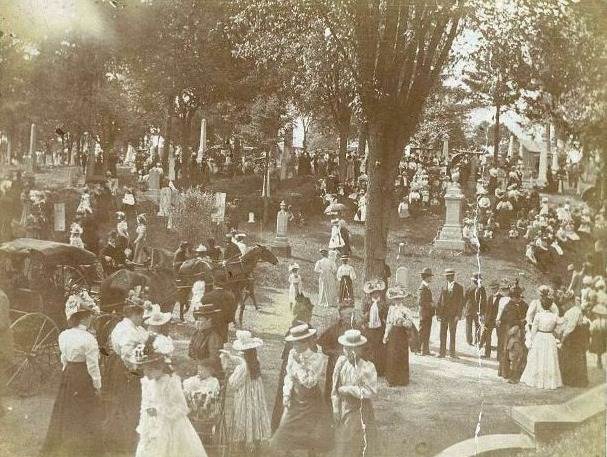Delve Into History: Bizarre Hobbies Of Victorian You Have Never Heard Before
The Victorian era, from 1837 to 1901, saw remarkable transformations, including the Industrial Revolution’s advancements in manufacturing, transportation, and communication.
These changes, coupled with shifting social norms and a growing interest in science and the arts, fostered a variety of unique hobbies.
Have you ever wondered what their pastimes were during that period? Let’s explore some of the unusual entertainments that fascinated Victorians.
1. Watching Louis Lavater’s Dog Orchestra

Louis Lavater’s Dog Orchestra was a unique Victorian-era circus act featuring six dogs trained to play instruments attached to their paws.
Each dog had a specific role: Jack on trombone, Tim on bass, Patsey on 1st violin, Prince on the big drum, Bob on the little drum, and Peter on cymbals. The “gorgeously dressed” dogs played their instruments harmoniously.
Training the dogs was a huge challenge. Prince, the drummer, was too excitable, and Jack took three months to learn to stand on two legs for 30 minutes to play the trombone. Occasionally, the dogs squabbled when Lavater wasn’t looking.
The novelty of the dog orchestra drew significant attention and admiration from Victorian audiences. An 1897 issue of The Strand Magazine reported that Lavater bought dogs for 18 pence to 5 shillings each and earned between £50 and £100 a week from their performances.
2. Animal impersonator performances

The well-known Charles Lauri Junior performed in theaters in London and Paris, transforming into animals like monkeys, cats, dogs, parrots, and ibises with a change of costume.
He starred in pantomimes and ballets, with one of his most famous productions being an “Indian pantomime ballet” called The Sioux, where he played a monkey.
The Sunday Times of London described it as “a rollicking and bustling kind of affair with a strong suggestion of Buffalo Bill’s show.”
In an 1894 issue of The Strand Magazine, Harry How described how Lauri “became” a monkey:
“The mask is an important item. This is put on the lower part of the face, creating the animal’s heavy, protruding jaw. Made of chocolate-colored leather, it has small straps. The eyebrows move with a concealed thread in his heavy dress. Lauri has a spring in his mouth that works the animal’s mouth, showing two rows of ivory teeth.”
3. Burlesque bullfight shows

This unusual “bullfight” intrigued Queen Victoria, who sent a telegram to the organizers, as reported by The Strand Magazine in 1899:
“The Queen is inquiring about the rumored bullfight. Please telegraph precisely what is proposed. Even if the intention is only burlesque with dogs, the Queen is anxious there should be no cruelty.”
Contrary to expectations, no real bulls were involved. Instead, the show featured dogs named Shutthatdor and Bangthatdor, dressed in padded bull costumes, facing off against a “matador.”
One account described the dog’s “bloodshot eyes rolling from side to side like balls of fire; he was cautiously followed by the man who would pretend to defeat him using a tin sword firmly gripped in his right hand.”
The dog would then charge, and the matador would theatrically place decorated sticks into the dog’s costume, “killing” the bull. The dog would then dramatically pretend to be dead and be dragged from the arena in a sack pulled by a horse.
After the performance, each dog received well-earned treats for their roles.
4. Clown Acts by Richard Usher

On July 2, 1818, Usher the Clown amazed the crowd by riding in a boat pulled by four geese on the Thames River.
Starting at Blackfriars Bridge, he climbed into a tub-like boat drawn by four geese. The birds pulled him upriver past the newly completed Waterloo Bridge, with huge crowds cheering him on.
Geese are known to be difficult, but Usher managed them well. One newspaper reported, “For some time they were quite tractable…he went on swimmingly, but at times they were quite restless and not easily managed.”
The boat made it as far as Vauxhall, likely aided by the rising tide, but it was still an impressive sight.
Usher as a versatile performer known for tight-rope walking and daring acts like dancing on red-hot iron, attracted large crowds. In 1819, he repeated his act with a cart pulled by a cat. Both stunts were popular and widely imitated.
Despite his fame, Usher the Clown is almost forgotten today. Perhaps his stunts could be recreated at the Waterloo Festival, with people dressed as geese and cats, but without the dangerous elements!
5. Anthropomorphic taxidermy displays

An anthropomorphic taxidermy is a form of taxidermy where animals are posed and arranged to resemble human activities or behaviors. It requires meticulous skills to preserve and pose the animals realistically, often creating surreal and visually striking displays.
During Victorian times, people loved collecting stuffed animals that looked like they were doing human things, like having weddings with kittens or playing with frogs at playgrounds. These displays mixed their interest in nature and imagination.
Hermann Ploucquet, a skilled German taxidermist at the Royal Museum in Stuttgart, impressed notable figures like Charlotte Bronte, Charles Darwin, and Charles Dickens. Even Queen Victoria admired his work, calling it “marvelous” in her diary.
Another notable taxidermist, Ferenc Mere from Hungary, spent a decade catching and stuffing frogs to make them look like people in everyday situations. His creations, on display at Froggyland in Split, Croatia, are still fascinating today, showing his dedication to this unique art form.
6. Pteridomania collecting

Victorians were fascinated by more than just stuffed animals. One strange trend was “fern fever,” or pteridomania, sparked in 1829 when British botanist Nathanial Bagshaw Ward accidentally saved a moth pupa in a sealed glass jar and noticed plants thriving inside.
He started growing ferns in glass cases called Wardian cases, known today as terrariums. These miniature ecosystems kept ferns healthy by maintaining humidity levels, perfect for Victorian homes polluted by city smoke.
As the craze grew, terrariums expanded to whole rooms filled with exotic plants like rubber and tea. They even protected plants on sea voyages, proving Ward’s invention invaluable.
7. Cemetery picnics

During Victorian times, cemeteries served as public parks for many people, offering open spaces and beautiful gardens when city parks were scarce.
In England and the United States, traditions like picnicking among gravestones were common, blending food with reflections on life and death.
Popular cemeteries, like Green Wood in New York and Woodland in Ohio, drew crowds dressed in their finest attire, enjoying leisurely strolls and picnics amid serene surroundings.
This hobby seems strange today, but it reflected their view of death as a part of daily life. With diseases like cholera and yellow fever prevalent, death was ever-present, affecting families across society.
Trips to cemeteries were a normal part of Victorian life, offering solace and space for contemplation amid life’s uncertainties.
8. Hair jewelry making

After Prince Albert died tragically in 1861, Queen Victoria never remarried, deeply mourning their legendary love. She wore a necklace containing locks of Albert’s hair, a poignant reminder of their bond.
Hair art existed long before the Victorian era, but it reached new heights during this time. People crafted intricate jewelry from hair, including earrings and brooches.
This trend, originating in Europe, spread to America during the Civil War, where families used hair as a way to mourn lost loved ones.
Hair used in these artworks wasn’t always from the deceased; friends exchanged locks as tokens of friendship, and wives made practical items like watch fobs for their husbands.
In a time of increasing commercialism, sentimental hair art became both a sincere gesture and a fashionable statement. Today, organizations preserve these artworks, and interest in hair jewelry-making persists, showing its enduring legacy.
9. Seaweed scrapbooking

During the Victorian era, alongside spiritualism and microscopic art, people enjoyed creating seaweed scrapbooks. They collected seaweed from beaches and arranged them artistically on paper, sometimes embellished with doilies or lace.
Despite unconventional materials, these scrapbooks often turned out surprisingly beautiful, reflecting Victorian’s knack for taming nature’s wildness into domestic art. Seaweed albums became popular extensions of pressing wildflowers between the pages of books.
Queen Victoria herself kept a seaweed scrapbook as a young girl. Books like A. B. Harvey’s “Sea Mosses” and essays by Eliza A. Jordson guided enthusiasts on preserving these “ocean flowers,” showcasing the hobby’s growing influence.
10. Post-mortem photography

Victorians were fascinated by postmortem photography, capturing deceased loved ones as a reminder of life’s uncertainties. This fascination, like other macabre aspects of Victorian culture, has its roots in the reality that death followed Victorian families around.
With poor hygiene and limited medical knowledge, diseases affected everyone, regardless of social status. Prince Albert’s early death plunged Queen Victoria into 40 years of mourning, shaping Victorian culture with elaborate rituals of grief.
Victorians also valued “memento mori” items, which symbolized the inevitability of death. Postmortem portraits, especially with families posing alongside deceased members, became expressions of this concept.
Photographers took great care to present the deceased as lifelike, highlighting features affected by diseases like tuberculosis. These photographs, though unusual to modern eyes, reflect how Victorians approached mortality and remembrance.
11. Attending freak shows

In Victorian times, many sought weekend entertainment at “freak shows,” where crowds gathered to see individuals with unique physical conditions.
These shows featured famous figures like Joseph Merrick, known as the “Elephant Man,” and Krao from Siam, who had hypertrichosis, causing excessive hair growth.
These displays turned people into celebrities of sorts, although they often faced public ridicule. For individuals like Greta the Lobster Girl, who had ectrodactyly, these shows helped her earn a living in an era with limited job opportunities for those with disabilities.
Victorians were so fascinated by these spectacles that Punch Magazine termed it “deformito-mania.” The term “freak,” derived from “freak of nature,” became popular during this time.
12. Crystal gazing

Since ancient times, people have been intrigued by predicting and controlling their futures.
Throughout European history, occult practices like crystal and mirror gazing, palmistry, tarot reading, and astrology persisted into the Victorian era, as noted in Alex Owen’s “The Darkened Room: Women, Power, and Spiritualism in Late Victorian England.”
Victorians enthusiastically embraced these practices, particularly crystal gazing, with its elaborate rituals and associations with celestial alignments. Stories linking crystal balls to ancient Egyptian seers, such as one owned by the Countess of Blessington, added mystique, though lacking historical proof.
Despite some claiming that biblical figures like Ezekiel and Daniel used crystal gazing, there isn’t historical evidence to support these claims. Yet, Victorian society, deeply rooted in Christian traditions, found spiritualism and the occult intriguing and embraced them despite this contradiction.

